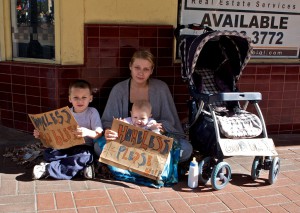The Solution to Homelessness
Utah’s New Program May End Homelessness
Despite drug treatments, mental therapy, and outright criminalization of homelessness, the number of homeless people continues to grow each year across the country. Utah seems to have found the answer.
 In 2005, Governor Jon Huntsman launched “Housing First,” a program brainstormed by his predecessor, Governor Olene Walker. The program took 17 homeless people in Salt Lake City and put them in apartments. The homeless could live in them permanently. The only condition was that they had to be good tenants, but no other strings were attached. The new tenants weren’t charged rent. The former homeless were given caseworkers who were to help them become self-sufficient, but if the homeless failed the treatment programs, they could still live in the apartments.
In 2005, Governor Jon Huntsman launched “Housing First,” a program brainstormed by his predecessor, Governor Olene Walker. The program took 17 homeless people in Salt Lake City and put them in apartments. The homeless could live in them permanently. The only condition was that they had to be good tenants, but no other strings were attached. The new tenants weren’t charged rent. The former homeless were given caseworkers who were to help them become self-sufficient, but if the homeless failed the treatment programs, they could still live in the apartments.
At first glance, Housing First looks like a welfare program that rewards people for being homeless. Housing First is a welfare program – but at least it’s a welfare program which saves money. According to a state study in 2005, Utah spent $16,670 per homeless person for emergency services and jail time while it only costs $11,000 to house each of them, a $5,670 difference per person.
More importantly, Housing First is actually working. The program started in 2005 with 17 people. In 2012, the program expanded to 2,000 people. Utah’s officials estimate that there has been a 74% reduction in the number of homeless people living in Utah’s streets. The state predicts that chronic homelessness will end by 2015. If Utah does solve its homeless problem, it would be the first state in the country to do so.
If Utah is giving away free housing, what incentives do people have to rent or purchase housing for themselves? First, about 30% of the former homeless have found work to pay for the apartments they live in. Second, the apartments only have a bed, a sink, and a bathroom.
Sometimes they will have a table or a chair, but these apartments are hardly the life of luxury. If people want a condo or a mansion, they still have to work for it. Finally, only people who have a disability and have been homeless for over a year or who have had four “episodes” of homelessness will qualify for the program.
Utah’s program of housing homeless people has been so successful that Wyoming is considering adopting the program. Housing First marks a fundamental change in how conservative states view homelessness. In solving “chronic homelessness,” Utah is treating homelessness like a disease rather than a social status, the same way we treat alcoholism as a disease today. This is surprising, given that Midwestern states like Utah and Wyoming often treat welfare programs with disdain.
Could Housing First create equal protection for the poor or a right to housing? Hardly. Courts consider economic class changeable and thus the poor are not protected–at least not to the extent race or gender is protected. Housing First is also unlikely to produce a right to housing. Fundamental rights are based on historical tradition and given how radical an idea Housing First is, even the most liberal judge would be hard pressed to find a right to housing in our nation’s history.
What our clients think
At LegalMatch, we value our client’s opinion and make it a point to address their concerns. You can refer to our reviews page if you want to know what our clients have to say about us.


Comments